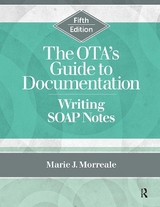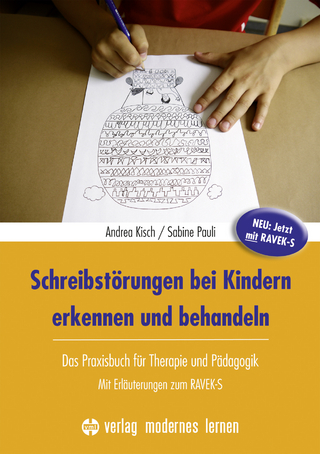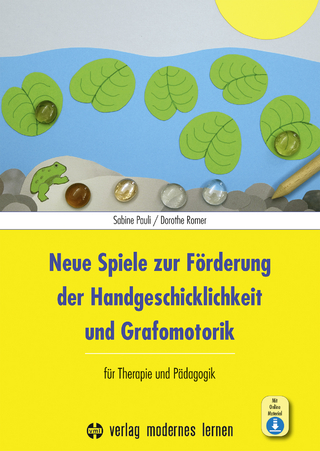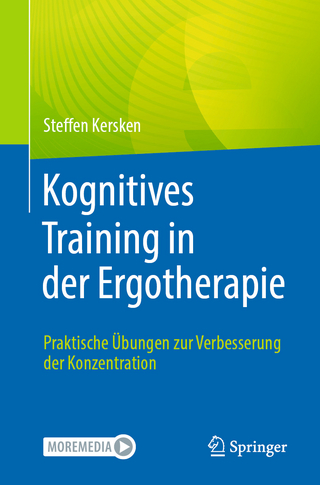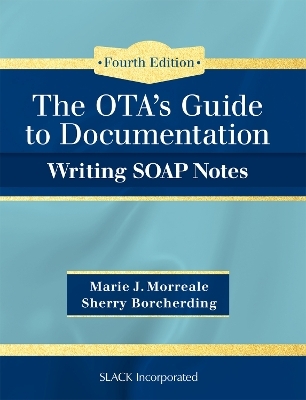
OTA's Guide to Documentation
SLACK Incorporated (Verlag)
978-1-63091-296-3 (ISBN)
- Titel erscheint in neuer Auflage
- Artikel merken
Now updated to itsFourth Edition, The OTA’s Guide to Documentation: Writing SOAP Notescontains the step-by-step instruction needed to learn occupational therapy documentation and meet the legal, ethical, and professional documentation standards required for clinical practice and reimbursement of services.
Written in an easy-to-read- format, this Fourth Edition by Marie J. Morreale and Sherry Borcherding will aid occupational therapy assistants (OTAs) in learning the purpose and standards of documentation throughout all stages of the occupational therapy process and different areas of clinical practice.
Essentials of documentation, reimbursement, and best practice are reflected in the many examples presented throughout The OTA’s Guide to Documentation: Writing SOAP Notes, Fourth Edition, including a practical method for goal writing (COAST), which is explained thoroughly.
Worksheets and learning activities provide the reader with multiple opportunities to practice observation skills and clinical reasoning, learn documentation methods, create occupation-based goals, and develop a repertoire of professional language. Answers to all the worksheets are provided to enable independent study, and a detachable summary sheet can be pulled out and carried to clinical sites as a reminder of the necessary contents for a SOAP note.
Templates are provided to assist beginning OTA students in formatting occupation-based SOAP notes and the task of documentation is broken down into smaller units to make learning easier. Other formats and methods of recording client care are also explained, such as the use of electronic health records and narrative notes. This text also presents an overview of the initial evaluation process delineating the roles of the OT and OTA and guidelines for implementing appropriate interventions.
New in the Fourth Edition:
Incorporation of the Occupational Therapy Practice Framework: Domain and Process, Third Edition and other updated American Occupational Therapy Association documents
Additional information on electronic health records and more examples from emerging niches of occupational therapy practice
Updated information to meet Medicare Part B and other third party payer requirements
Additional lists of professional language and abbreviations
Extra tips for avoiding common documentation mistakes
New tables, worksheets, and learning activities
Instructors in educational settings can visit www.efacultylounge.com for additional material to be used in the classroom.
Updated with new features and information,The OTA’s Guide to Documentation: Writing SOAP Notes, Fourth Edition offers both the instruction and multiple opportunities to practice documentation, providing OTAs with the necessary skills to record client care effectively.
Bonus Video Content:
When you purchase a new copy of The OTA’s Guide to Documentation: Writing SOAP Notes, Fourth Edition, you will receive access to scenario-based videos to practice the documentation process.
Marie J. Morreale, OTR/L taught occupational therapy assistant (OTA) students for 17 years at Rockland Community College, State University of New York. As an adjunct faculty member, her various courses included: Professional Issues and Documentation; Geriatric Principles; OT Skills; Advanced OT Skills; Therapeutic Activities; and Advanced Therapeutic Activities. Marie contributed significantly to curriculum development and served briefly as interim coordinator of the OTA Program. Marie graduated Summa Cum Laude from Quinnipiac College (now Quinnipiac University) in Hamden, Connecticut, and has clinical experience in a variety of OT practice settings including: inpatient and outpatient rehabilitation, long-term care, adult day care, home health, cognitive rehabilitation, and hand therapy. She maintained certification in hand therapy for over 20 years and also served several years on a home health Professional Advisory Committee, consulting on quality assurance issues. Marie enjoys professional writing and, in addition to co-authoring the prior two editions of this documentation manual, has published several other occupational therapy texts: The Occupational Therapist’s Workbook for Ensuring Clinical Competence and Developing Clinical Competence: A Workbook for the OTA. Additional published works include a chapter on documentation for The Occupational Therapy Manager, Fifth Edition, several OT articles and web-based continuing education courses. She is also a test item writer for the American Occupational Therapy Association continuing education products. In her spare time, Marie is active in her church community and has a passion for travel. Sherry Borcherding, MA, OTR/L is retired from the faculty of the University of Missouri–Columbia, where she taught for 15 years. During the time she was on the faculty, she taught disability awareness, complementary therapy, clinical ethics, frames of reference, psychopathology, loss and disability, long term care, wellness, and a three-semester fieldwork sequence designed to develop critical thinking, clinical reasoning, and documentation skills. As a part of the fieldwork and documentation courses, she filmed simulated occupational therapy interventions for student use in class. Three of these “movies” are available on www.efacultylounge.com with this edition of the book. Sherry graduated with honors from Texas Woman’s University, Denton, Texas with a BS in occupational therapy and went on to complete her master’s in special education with special faculty commendation at George Peabody College, Nashville, Tennessee. Along with her staff positions in rehabilitation, home health, and pediatrics, she assumed a number of management roles, including Chief Occupational Therapist at East Texas Treatment Center, Kilgore, Texas; Director of Occupational Therapy at Mid-Missouri Mental Health Center, Columbia, Missouri; and Director of Rehabilitation Services at Transitional Housing Services, Columbia, Missouri. She has planned, developed, and directed occupational therapy programs at Capitol Region Medical Center, Jefferson City, Missouri and at Charter Behavioral Health Center, Columbia, Missouri. Sherry is a lifelong learner. Since her retirement, she has further expanded her private practice devoted to complementary and alternative therapies. She is certified in CranioSacral Therapy through Upledger Institute, Palm Beach Gardens, Florida, and is attuned as a Reiki master. She is currently learning Eden Energy Medicine. For leisure, Sherry enjoys music, English country dance, and all kinds of three-dimensional art. Her pottery has appeared in several local shows over the past several years. For 10 years, she volunteered with the Community Emergency Response team doing logistics.
Acknowledgments
About the Authors
Chapter 1 Documenting the Occupational Therapy Process
Chapter 2 The Health Record
Chapter 3 Billing and Reimbursement
Chapter 4 Using Professional Terminology
Chapter 5 Avoiding Common Documentation Mistakes
Chapter 6 Writing the “S”—Subjective
Chapter 7 Writing the “O”—Objective
Chapter 8 Tips for Writing a Better “O”
Chapter 9 Writing the “A”—Assessment
Chapter 10 Writing the “P”—Plan
Chapter 11 Documenting Special Situations
Chapter 12 Improving Observation Skills and Refining Your Note
Chapter 13 Making Good Notes Even Better
Chapter 14 Evaluation and Intervention Planning
Chapter 15 Goals and Interventions
Chapter 16 Documenting Different Stages of Intervention
Chapter 17 Documentation in Different Practice Settings
Chapter 18 Examples of Different Kinds of Notes
Appendix: Suggestions for Completing the Worksheets
Index
| Erscheinungsdatum | 06.07.2017 |
|---|---|
| Sprache | englisch |
| Maße | 216 x 279 mm |
| Gewicht | 885 g |
| Themenwelt | Medizin / Pharmazie ► Physiotherapie / Ergotherapie ► Ergotherapie |
| ISBN-10 | 1-63091-296-4 / 1630912964 |
| ISBN-13 | 978-1-63091-296-3 / 9781630912963 |
| Zustand | Neuware |
| Haben Sie eine Frage zum Produkt? |
aus dem Bereich
